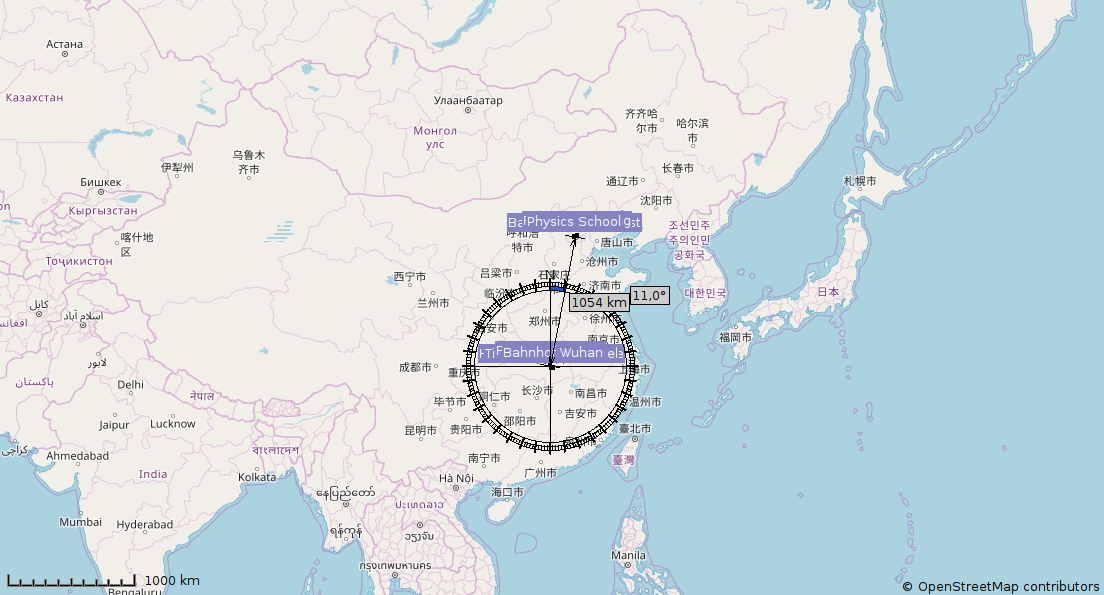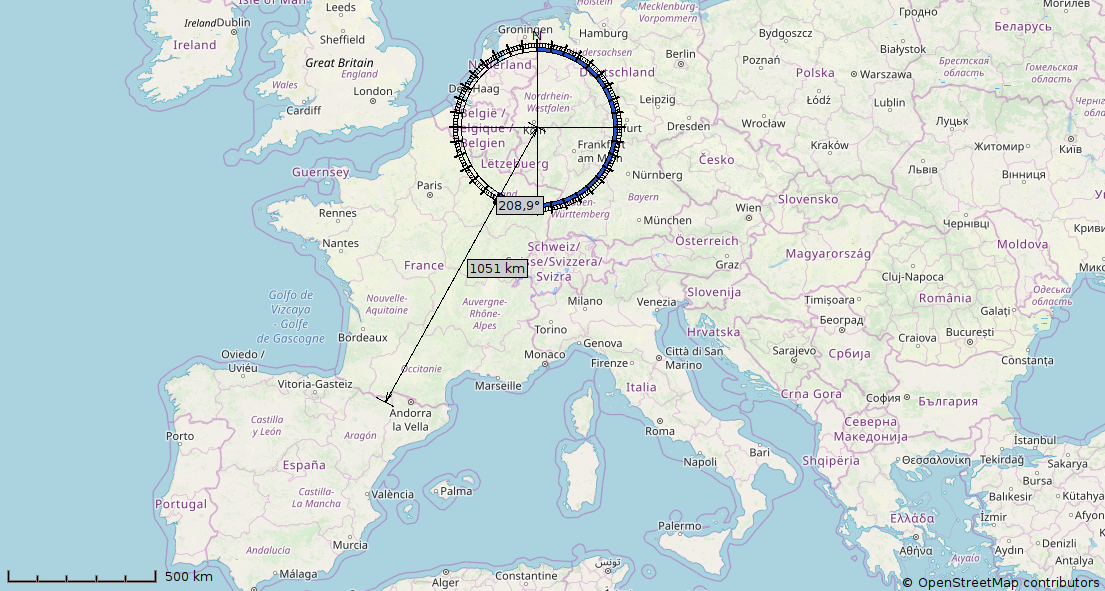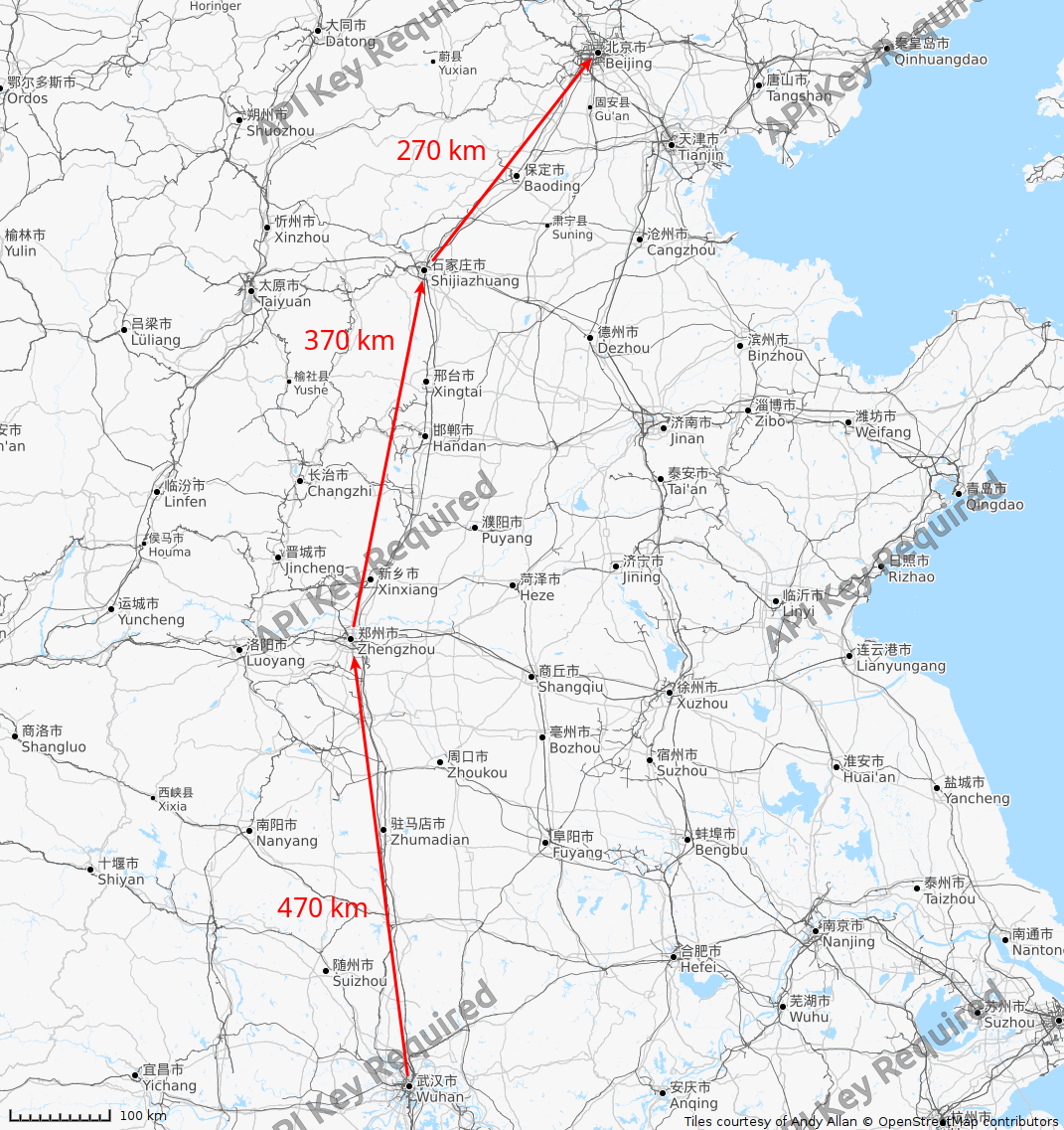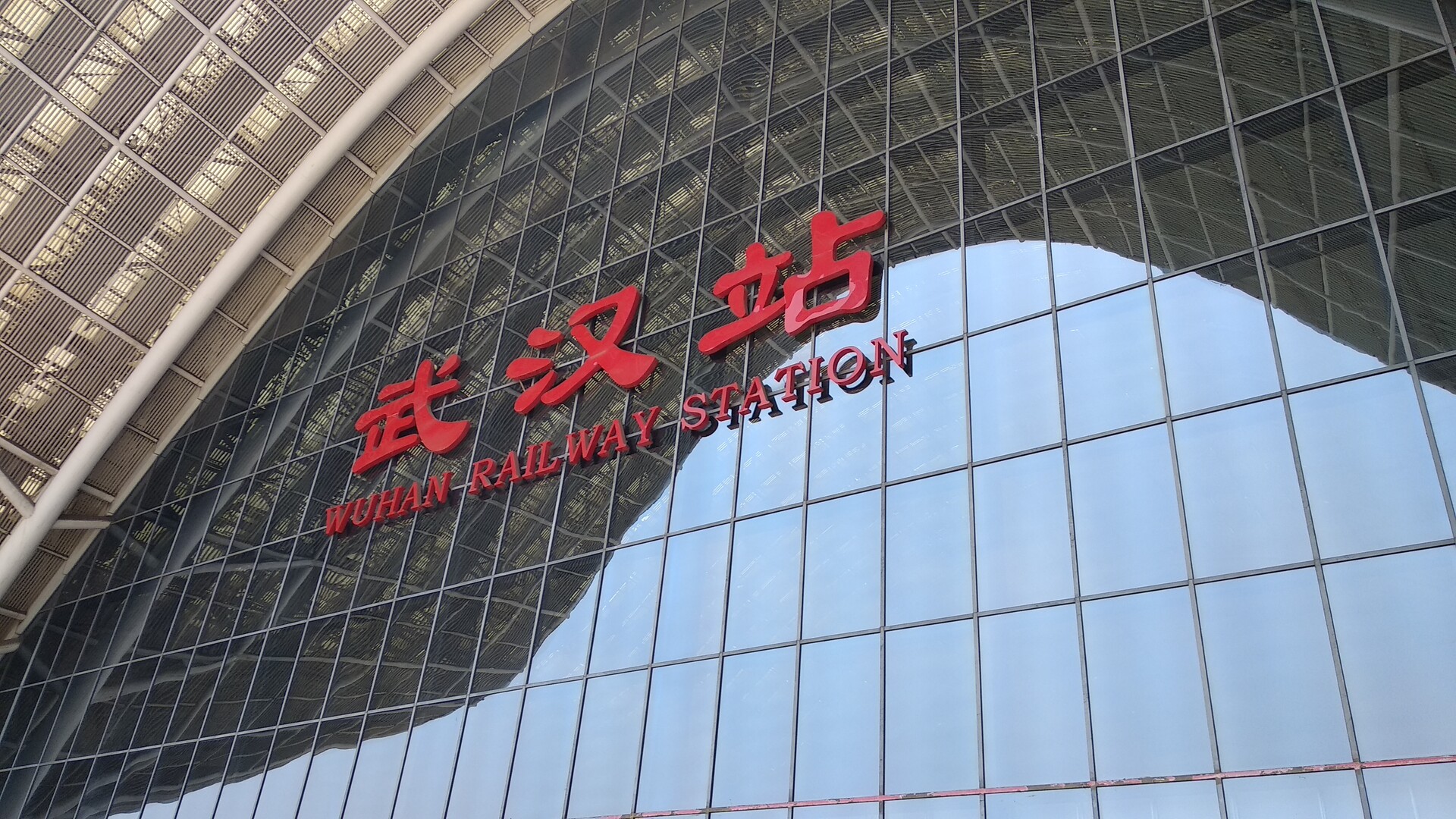Train Ride from Wǔhàn (武汉市) to Běijīng (北京市)
After the first week I had to do a transfer from Wǔhàn to Běijīng. These are around 1050 km linear distance apart:
If you started in Bonn and went 1050 km linear distance, you would already be in Spain. This should give a first impression on the size of China.
There are two sensible options to travel this distance: plane and train. Booking a plane with a German website would have cost me around 300 EUR. The airports in both cities are a bit further out, so this is not really the most comfortable option. The Chinese railway system supposedly is very good according to a colleague, so I checked their booking website and saw that the connection is available for 78 USD in second class on a G-class train. This is the fastest type going between 250 to 400 km/h.
The trip would take 4:20 hours. They supposedly have separate tracks for the fast trains, so this should run very smoothly. The train only stops two times on that route, see this map:
If you would take the same distances in Europe, the train would only stop in Berlin, Köln, Basel and Milano.
We have booked the train via the website and payed in USD currency. The tickets would have to be picked up at any train station in mainland China, similar to the process of Deutsche Bahn.
At the Wǔhàn Main Station we have picked up our tickets. As always there have been multiple queues and the ones that we have picked was the slowest one. There was one person wanting to purchase a ticket, and somehow it took five minutes for him to figure out which ticket to buy. Once it was our turn we just presented them with booking numbers and passports and got our paper tickets.
The departure is on the third floor, we had to go up two levels. There was a security check, though not as thorough as at an airport. I did not have to empty my pockets before going through the security scanner. They wanted to check me with the handheld metal detector, but that was no way as thorough as they had checked me in Běijīng on my transfer there. We proceeded to our gate, it really felt like an airport. Before we even got to the security check we had to present our passport and ticket again. From behind the security one could get a first glance on the trains.
According to the instructions from the booking process we have planned to be at the station 90 minutes before the departure. We were lucky and did not have any waiting time except when picking up the tickets, so we just spend a lot of time sitting near the gate. Eventually we got to go down to the train platform. On the ground there are printed labels indicating the train car numbers.
All this was much more organized than the ICE trains in Germany. There the train just stops roughly at a particular position. One of the posters there tells you which car is located in which section, but that only works roughly. Sometimes the order of the train cars is reversed. This just does not happen with Chinese high speed rail. Also inside the train all seats face forward, which is nice for people who have a hard time riding backwards. German trains are build in a symmetrical way such that the cars do not have an orientation. This means that half of the seats are oriented backwards, though.
During the first part of the trip the train was going around 300 km/h, which you can only get between Siegburg and Frankfurt am Main in Germany. During the excursion the guide told us that there had been an accident and therefore the trains were operating at only 70 % of their maximum speed at the moment. I am not sure whether the 400 km/h that are advertised are before or after that reduction, though.
The tickets were checked again inside the train. One nice thing about having all reserved-seats was that the crew knew where one would sit. I have seen a sleeping passenger being woken up just before his exit station. This is a very nice service. In general there are extremely many people working in various places. A German train might have a few conductors on it. In China you have many conductors, several cleaning people and a couple of policemen on the train. Also at the security posts there usually are people just standing there without an apparent task at hand. This feels a bit strange, but apparently it is just a cultural thing to have more people around. Also in the metro in Běijīng I saw people just standing next to the escalators and presumably making sure that people use them correctly.
On the over four hours of train ride I eventually got hungry. I went to the board restaurant where the two waitresses enthusiastically read my allergy card and told me with gestures that this was a really good idea. They eventually gave me a plastic box which had a plastic wrapped pack of ramen noodles, some wrapped pack with powder and vegetables and a plastic fork in it. Then they poured some hot water over it and told me to wait two minutes before starting to eat. It did cost 25 CNY. At some store you could probably get it much cheaper. Eating the entangled noodles with the plastic fork proved difficult as they always slipped off and fell back into the container.
We arrived at the west railway station, Běijīng Xī (北京西), just on time. The Chinese high speed rail is separated from the regular trains and therefore there are no delays. Normal trains supposedly have regular delays, though. At the exit we had to present our train ticket yet again to leave the station. From there we made it to the subway. With the whole Open Street Map for Běijīng on my phone I was quickly able to figure out that we would need to take the line 9 to Guójiātúshūguǎn (国家图书馆) and do a transfer to line 4. That one would then take us to Běijīng Dàxué Dōngmén (北京大学东门), the east gate of the Běijīng university. Just as in Wǔhàn the subway system is easily accessible and transfers are just exiting the train and going to the opposite platform. We arrived on Sunday late afternoon and the subways were packed, much more than in Wǔhàn.
One can compare this train trip to one which I did after my journey to China. I wanted to go from Bonn to Dortmund. I had booked an IC train which was supposed to take around 1:30 hours. When I arrived at the station in Bonn I checked with the DB Navigator app whether something had changed. And it said that the train was cancelled completely. So I looked up alternatives and found the combination of a RB to Köln Messe Deutz and from there an ICE to Dortmund. The RB would be leaving a minute after I checked, so I ran and managed to get into it.
That RB then needed to do an extended stop in Köln South station because of some electronics hiccups at Köln West. After being like 15 minutes late compared to the original schedule of that train we finally started off again only to stop midway before Köln West. It took longer and longer and I eventually managed to board the ICE train. There in the car that I was in the air conditioning was broken. With 38 degrees Celsius on the outside this was a sauna outright.
But the ICE was also accumulating delays because they waited in Köln to get everyone from other delayed trains onboard. This likely is a good thing because I managed to get it as well and potentially others from other delayed trains. But then between the cities of the Ruhrgebiet the train was going really slow and accumulated even more delays. In the end I managed to sip up my buffer of 20 minutes and got there 45 minutes late, so over on hour later for a trip that was supposed to take 1:30 hours in the beginning.
I really like the train as a concept, but Germany is just screwing it.






